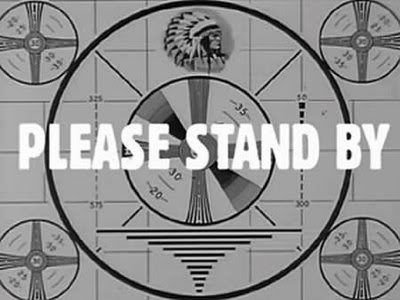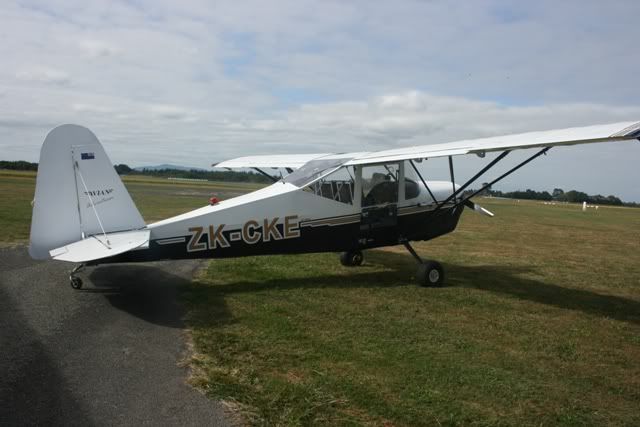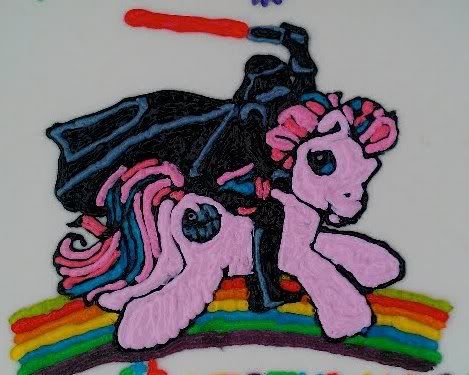Post by cutaway on Sept 5, 2008 13:19:05 GMT 12
I know of "F-19A" models being released to the public to confuse communist spy rings during the 1980s, But is it possible this aircraft or somthing like it exists?. Its becouse the design from Monogram models is based on a design by Loral and is also more aircraft-like than the one made by Testors.
Wherever it is real or not, I believe the "F-19A Specter" would be a feasible design for a fighter aircraft, even for todays technology.
The first image below is the concept by Loral Inc
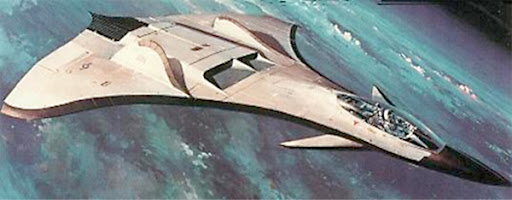

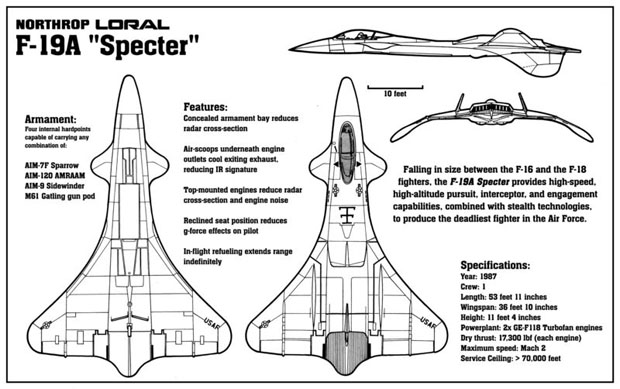
Wherever it is real or not, I believe the "F-19A Specter" would be a feasible design for a fighter aircraft, even for todays technology.
The first image below is the concept by Loral Inc



In 1972, the United States Air Force issued a Request For Proposal (RFP) to Northrop, McDonnell-Douglas, and General Dynamics for a supersonic stealth aircraft.
All three companies submitted design proposals in early 1974. On 2 September 1974, it was quietly announced that Northrop would be prime contractor of PROJECT SPECTER
(It is interesting to note that the design submitted by General Dynamics would later be the “cranked arrow” F-16XL that would later compete against the F-15E in the light strike fighter/bomber competition in 1985.)
Northrop went to work immediately following the contract announcement. Special Project 711 was underway. Northrop had to invent new technologies for project 711. Engineers decided to incorporate a Fly-by-Wire flight control system, use of carbon-fiber epoxy as the main component of the airframe and the new Sperry APQ-118 fire control system. Project 711 also had to make use of the new Hughes AIM-78X low observable air-to-air/air-to-ground missile. The decision was also made that there would be six preproduction prototype aircraft.
To speed the design and build process, Northrop used many “off-the-shelf” parts. The nose landing gear system was from the F-5E Tiger II, the main landing gear came from the F-18A Hornet, in which Northrop is sub-sub-contractor. The main landing gear wheels and came from mothballed F-4C/D/E Phantom II’s in the Boneyard. Northrop, acting as a foreign entity through the permission of the President of the United States, purchased F-16A canopy assemblies for the project. The majority of the avionics were also proven avionics systems found in other aircraft minus specialized ECM equipment.
Design features included a wing folding mechanism that are horizontal for take-off and landing, then can droop up to 30 degrees in flight and then fold back on top of the wing when parked. The droop tip design extends the cruise range by allowing the aircraft to ride its own shock wave, hence reducing fuel consumption. The intake ramps pivot up to fair over the intake for extended glide stealth target approach, the breather doors for the engine compressors open when the aircraft performing high-g maneuvers. The Rapid Rotating Weapon Pallet (RRWP) provides a wide variety of mission profiles for all weapons.
On August 2, 1982, Special Project 711, now officially called the F-19A Specter, made it’s official rollout from the Northrop Black Cat facility under extreme secrecy. Following a Northrop flight test program, the aircraft was delivered to the Air Force on 15 December 1982. Specter One arrived at Groom Lake, Nevada under the cover of darkness by Lt. Col. Chester “Devastator” Moore. Specter One became part of the 440th Test Wing, 199th Test and Evaluation Squadron. Specter crews were chosen from the top fighter and reconnaissance pilots in the Air Force.
A total of six pre-production Engineering Manufacturing and Design (EMD) test aircraft were delivered to the 199th in 1982 and 1983.
Specter One was used for flight envelope testing.
Specter Two was used for stealth and penetration testing.
Specter Three was the armament test bed.
Specter Four was used for ballistics tests.
Specter Five was the dedicated pilot training aircraft.
Specter Six, also know as “Groom’s Gal” was the first Specter to be used in a full up exercise and had the complete suite of defensive, offensive avionics suites installed. Complete avionic suites would be added to all aircraft by May 1984.
Specter Six, also know as “Groom’s Gal” was the first Specter to be used in a full up exercise and had the complete suite of defensive, offensive avionics suites installed. Complete avionic suites would be added to all aircraft by May 1984
During the Operational Test and Evaluation (OT&E) of the Specter in the May 1984, the aircrafts performed flawlessly. The F-19 held a mission capable rate of 98.7% of all sorties tasked. When word was delivered that the F-19 met all mission requirements; the decision was made to put the F-19 into low rate initial production (LRIP).
An order was placed in July 1986 for 100 F-19A and 25 F-19B two-place fighter/trainer aircraft from Northrop for the USAF. It looked as though the Specter program had nothing but smooth sailing ahead of it.
As with all black budget programs, no disclosure was made due to national security, but that year, Congress had changed the rules concerning black budget programs. Congress had demanded where and how much money was being spent on the program. After intense pressure, then President Ronald Reagan released all information on PROJECT SPECTER. The cost overruns were astronomical. The F-19 was 10 million dollars over budget. When word of this circulated around Capital Hill, cancellation of the program was imminent.
Almost one year to the day, July 1987, Congress announced that the F-19 Specter was to be cancelled. On an interesting note, Lockheed already had a stealth aircraft, the F-117 Nighthawk, flying at the Tonopah Test Range, Nevada. But since both aircraft teams were sworn to secrecy, neither knew of each other’s existence.
The news was devastating to both Northrop and the Specter team at Groom Lake. Due to the secret nature of the aircraft, it was decided that all six Specter stay at Groom Lake and be disposition on site:
Specter Two was stripped of it components and was towed to the flight line fire pit for fire training and of last report was completely destroyed after one fire exercise due to the carbon fiber make up of the aircraft.
Specter Three was used as a maintenance trainer in Composite Airframe Battle Damage Repair (CABDR) and by 1995 there was little left of the aircraft to be recognizable as an F-19; it was eventually hauled away to an undisclosed location. rumour has it that it is buried under the Bellagio Hotel in Las Vegas.
Specter Four was placed out on the live fire test range and was eventually destroyed by it’s rival, the F-117A Nighthawk, aircraft number 790, in a bombing run.
Specter Five was destroyed in a training accident in 1985 when the primary flight control hydraulic pump failed in flight. The pilot ejected safely.
Specter Six was also destroyed in a training accident in 1986 when pilot, Capt. Dirk “Squarejaw” Pottenger over stressed the airframe in a 15g turn and catastrophic airframe damage occurred. Luckily, Squarejaw did eject safely and now in the Guinness Book of World Records as the only human to survive a 15g ejection from an aircraft.
Perhaps the most interesting disposition is Specter One. Specter One remained at Groom Lake for limited flight-testing. This aircraft was used to test a wide range of programs. Specter One holds the distinction as being the test bed for the now famous “Hill II” paint scheme, found on the F-4G Wild Weasel. In 1988, Specter One was turned over to NASA for High-Speed Stealth Research (HSSR). When NASA finished the HSSR program in 1994, it was stripped of all equipment and the USAF released the aircraft for static display at the Pima County Air Museum in Arizona. Specter One remained on display until 1997, when it was discovered, that a foreign government had, in essence, copied the F-19. The USAF took possession of the aircraft and it was towed to nearby Davis-Monthan Air Force Base. It is rumoured that the aircraft stayed at Davis-Monthan for two-years under going an extensive modification program. In the summer of 1999, the last remaining F-19A Specter was seen taking-off from the main runway at dusk, never to be seen again.
EPILOGUE
Northrop tried to regain its glory in the fighter aircraft industry in the 1980s with the F-20 Tigershark. Even though it was flown by famous test pilot, Charles “Chuck” Yeager and endorsed by him as the finest jet fighter ever built, the USAF had no need for the aircraft. Since the U.S. would not buy the aircraft, there was little hope for foreign sales. After a series of fatal crashes, the F-20 was cancelled. But, Northrop had an ace in the hole.
Northrop, vowing not to be counted out as a contender in the stealth race, won the B-2 stealth bomber contract. The B-2A has met all design requirements and is in full production. But all was not well.
Once again the USAF released a design requirement for the Advanced Technology Fighter (ATF) program. Competing bids by Lockheed/Boeing/General Dynamics and Northrop/McDonnell-Douglas were awarded and a fly-off would determine the winner. Once again Lockheed came out on top and was awarded the ATF contract for the F-22 Raptor. Sources state that
Northrop’s entry, the YF-23, was clearly a superior aircraft and the reason it as not awarded to them was that Northrop held the B-2 bomber contract.
As for F-19A, serial number AF81-0001, Specter One, its current location and mission are unknown. Several sources, close to the author, have stated seeing the F-19A during operations over Kosovo and recently in OPERATION IRAQI FREEDOM. Air Force officials do admit that Specter One is still in service and is only used when absolutely necessary. There is some talk as to producing ten more F-19’s with updated 21st Century technology and carrying the F-19C designation. Only time and budget will tell…
All three companies submitted design proposals in early 1974. On 2 September 1974, it was quietly announced that Northrop would be prime contractor of PROJECT SPECTER
(It is interesting to note that the design submitted by General Dynamics would later be the “cranked arrow” F-16XL that would later compete against the F-15E in the light strike fighter/bomber competition in 1985.)
Northrop went to work immediately following the contract announcement. Special Project 711 was underway. Northrop had to invent new technologies for project 711. Engineers decided to incorporate a Fly-by-Wire flight control system, use of carbon-fiber epoxy as the main component of the airframe and the new Sperry APQ-118 fire control system. Project 711 also had to make use of the new Hughes AIM-78X low observable air-to-air/air-to-ground missile. The decision was also made that there would be six preproduction prototype aircraft.
To speed the design and build process, Northrop used many “off-the-shelf” parts. The nose landing gear system was from the F-5E Tiger II, the main landing gear came from the F-18A Hornet, in which Northrop is sub-sub-contractor. The main landing gear wheels and came from mothballed F-4C/D/E Phantom II’s in the Boneyard. Northrop, acting as a foreign entity through the permission of the President of the United States, purchased F-16A canopy assemblies for the project. The majority of the avionics were also proven avionics systems found in other aircraft minus specialized ECM equipment.
Design features included a wing folding mechanism that are horizontal for take-off and landing, then can droop up to 30 degrees in flight and then fold back on top of the wing when parked. The droop tip design extends the cruise range by allowing the aircraft to ride its own shock wave, hence reducing fuel consumption. The intake ramps pivot up to fair over the intake for extended glide stealth target approach, the breather doors for the engine compressors open when the aircraft performing high-g maneuvers. The Rapid Rotating Weapon Pallet (RRWP) provides a wide variety of mission profiles for all weapons.
On August 2, 1982, Special Project 711, now officially called the F-19A Specter, made it’s official rollout from the Northrop Black Cat facility under extreme secrecy. Following a Northrop flight test program, the aircraft was delivered to the Air Force on 15 December 1982. Specter One arrived at Groom Lake, Nevada under the cover of darkness by Lt. Col. Chester “Devastator” Moore. Specter One became part of the 440th Test Wing, 199th Test and Evaluation Squadron. Specter crews were chosen from the top fighter and reconnaissance pilots in the Air Force.
A total of six pre-production Engineering Manufacturing and Design (EMD) test aircraft were delivered to the 199th in 1982 and 1983.
Specter One was used for flight envelope testing.
Specter Two was used for stealth and penetration testing.
Specter Three was the armament test bed.
Specter Four was used for ballistics tests.
Specter Five was the dedicated pilot training aircraft.
Specter Six, also know as “Groom’s Gal” was the first Specter to be used in a full up exercise and had the complete suite of defensive, offensive avionics suites installed. Complete avionic suites would be added to all aircraft by May 1984.
Specter Six, also know as “Groom’s Gal” was the first Specter to be used in a full up exercise and had the complete suite of defensive, offensive avionics suites installed. Complete avionic suites would be added to all aircraft by May 1984
During the Operational Test and Evaluation (OT&E) of the Specter in the May 1984, the aircrafts performed flawlessly. The F-19 held a mission capable rate of 98.7% of all sorties tasked. When word was delivered that the F-19 met all mission requirements; the decision was made to put the F-19 into low rate initial production (LRIP).
An order was placed in July 1986 for 100 F-19A and 25 F-19B two-place fighter/trainer aircraft from Northrop for the USAF. It looked as though the Specter program had nothing but smooth sailing ahead of it.
As with all black budget programs, no disclosure was made due to national security, but that year, Congress had changed the rules concerning black budget programs. Congress had demanded where and how much money was being spent on the program. After intense pressure, then President Ronald Reagan released all information on PROJECT SPECTER. The cost overruns were astronomical. The F-19 was 10 million dollars over budget. When word of this circulated around Capital Hill, cancellation of the program was imminent.
Almost one year to the day, July 1987, Congress announced that the F-19 Specter was to be cancelled. On an interesting note, Lockheed already had a stealth aircraft, the F-117 Nighthawk, flying at the Tonopah Test Range, Nevada. But since both aircraft teams were sworn to secrecy, neither knew of each other’s existence.
The news was devastating to both Northrop and the Specter team at Groom Lake. Due to the secret nature of the aircraft, it was decided that all six Specter stay at Groom Lake and be disposition on site:
Specter Two was stripped of it components and was towed to the flight line fire pit for fire training and of last report was completely destroyed after one fire exercise due to the carbon fiber make up of the aircraft.
Specter Three was used as a maintenance trainer in Composite Airframe Battle Damage Repair (CABDR) and by 1995 there was little left of the aircraft to be recognizable as an F-19; it was eventually hauled away to an undisclosed location. rumour has it that it is buried under the Bellagio Hotel in Las Vegas.
Specter Four was placed out on the live fire test range and was eventually destroyed by it’s rival, the F-117A Nighthawk, aircraft number 790, in a bombing run.
Specter Five was destroyed in a training accident in 1985 when the primary flight control hydraulic pump failed in flight. The pilot ejected safely.
Specter Six was also destroyed in a training accident in 1986 when pilot, Capt. Dirk “Squarejaw” Pottenger over stressed the airframe in a 15g turn and catastrophic airframe damage occurred. Luckily, Squarejaw did eject safely and now in the Guinness Book of World Records as the only human to survive a 15g ejection from an aircraft.
Perhaps the most interesting disposition is Specter One. Specter One remained at Groom Lake for limited flight-testing. This aircraft was used to test a wide range of programs. Specter One holds the distinction as being the test bed for the now famous “Hill II” paint scheme, found on the F-4G Wild Weasel. In 1988, Specter One was turned over to NASA for High-Speed Stealth Research (HSSR). When NASA finished the HSSR program in 1994, it was stripped of all equipment and the USAF released the aircraft for static display at the Pima County Air Museum in Arizona. Specter One remained on display until 1997, when it was discovered, that a foreign government had, in essence, copied the F-19. The USAF took possession of the aircraft and it was towed to nearby Davis-Monthan Air Force Base. It is rumoured that the aircraft stayed at Davis-Monthan for two-years under going an extensive modification program. In the summer of 1999, the last remaining F-19A Specter was seen taking-off from the main runway at dusk, never to be seen again.
EPILOGUE
Northrop tried to regain its glory in the fighter aircraft industry in the 1980s with the F-20 Tigershark. Even though it was flown by famous test pilot, Charles “Chuck” Yeager and endorsed by him as the finest jet fighter ever built, the USAF had no need for the aircraft. Since the U.S. would not buy the aircraft, there was little hope for foreign sales. After a series of fatal crashes, the F-20 was cancelled. But, Northrop had an ace in the hole.
Northrop, vowing not to be counted out as a contender in the stealth race, won the B-2 stealth bomber contract. The B-2A has met all design requirements and is in full production. But all was not well.
Once again the USAF released a design requirement for the Advanced Technology Fighter (ATF) program. Competing bids by Lockheed/Boeing/General Dynamics and Northrop/McDonnell-Douglas were awarded and a fly-off would determine the winner. Once again Lockheed came out on top and was awarded the ATF contract for the F-22 Raptor. Sources state that
Northrop’s entry, the YF-23, was clearly a superior aircraft and the reason it as not awarded to them was that Northrop held the B-2 bomber contract.
As for F-19A, serial number AF81-0001, Specter One, its current location and mission are unknown. Several sources, close to the author, have stated seeing the F-19A during operations over Kosovo and recently in OPERATION IRAQI FREEDOM. Air Force officials do admit that Specter One is still in service and is only used when absolutely necessary. There is some talk as to producing ten more F-19’s with updated 21st Century technology and carrying the F-19C designation. Only time and budget will tell…







 !!! ;D
!!! ;D